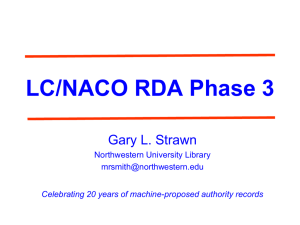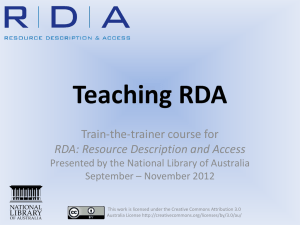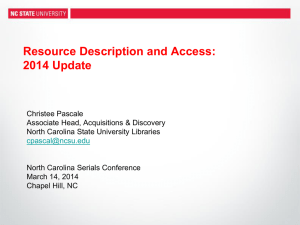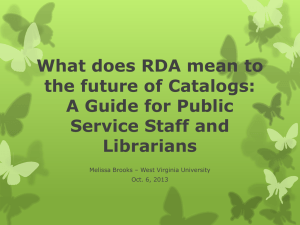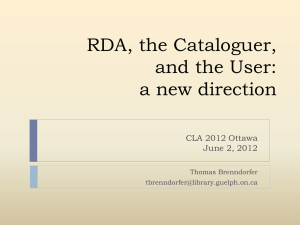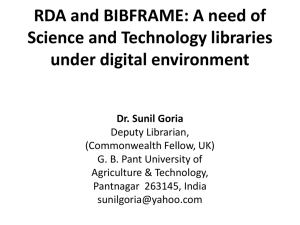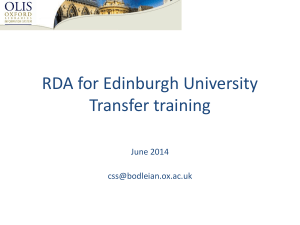RDA, The Next Phase
advertisement
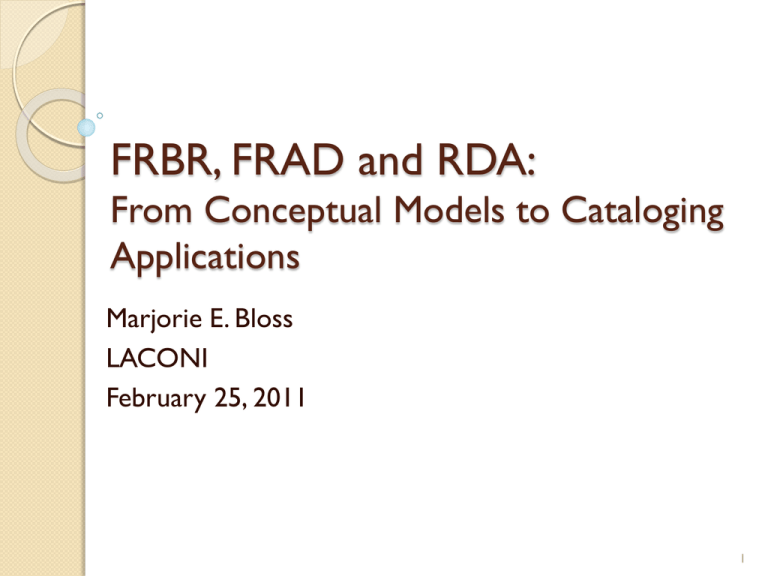
FRBR, FRAD and RDA: From Conceptual Models to Cataloging Applications Marjorie E. Bloss LACONI February 25, 2011 1 In This Presentation Why RDA? The Foundation for RDA (FRBR and FRAD) RDA Content – rules and examples RDA Toolkit – what it looks like and how it works What’s next? Anglo-American Cataloging Traditions Began with Panizzi, Jewett, and Cutter to a number of cataloging codes through the 1960s Attempts to develop one set of cataloging rules for both the US and the UK Development of Lubetzky’s “Paris Principles” led to AACR AACR2: one more attempt for one code, based on ISBD 3 Who Is Responsible? Committee of Principals AACR Fund Trustees/ Publishers Joint Steering Committee ALA CC:DA BL ACOC CCC CILIP LC 4 AACR2 Characteristics Created for a card catalog environment Provides rules for both description and display Is limited when describing digital materials Does not demonstrate how works are related to one another GOALS: RDA will be … A new standard for resource description and access Designed for the digital world • Optimized for use as an online product • Description and access of all resources • All types of content and media • Resulting records usable in the digital environment (Internet, Web OPACs, etc.) RDA will be … A consistent, flexible, and extensible framework Compatible with internationally established principles, models, and standards Primarily for use in libraries, but also adaptable across many information communities worldwide 7 Collaborations with other Communities International Meeting of Experts International Cataloguing Committee (IME ICC) IFLA Section on Cataloguing and its working groups on FRBR and FRAD RDA/MARC/MARBI ONIX (Publishers) RDA, Dublin Core, IEEE/LOM, Semantic Web ◦ “Data Modeling Meeting” - London 2007 RDA’s Foundation Functional Requirements for Bibliographic Records (FRBR) Functional Requirements for Authority Data (FRAD) Functional Requirements for Subject Authority Data (FRSAD – in progress) FRBR Terminology Entities (categories) Attributes (characteristics) Relationships (between and among entities) FRBR Group 1 Entities Work Expression Manifestation Item FRBR Group 2 Entities Those responsible for intellectual or artistic content, physical production and dissemination, or custodianship of Group 1 entities ◦ Persons ◦ Families ◦ Corporate bodies FRBR Group 3 Entities Subjects Can include any Group 1 or Group 2 entity plus Concepts Objects Events Place Group 1 Entities Work is realized through Expression is embodied in Manifestation is exemplified by Item Work A distinct intellectual or artistic creation Very abstract! – does not correspond with any tangible thing (At right : Shakespeare thinks about creating Romeo and Juliet) Expression The intellectual or artistic realization of a work Specific sequence of words in a textual work, translations, notes in a musical work, interpretations, etc. Still abstract! Manifestation The physical embodiment of an expression of a work An expression can be embodied in multiple manifestations (e.g. print, microform, digital) Item A single exemplar of a manifestation Related or Derivative Works User Tasks Associated with bibliographic data (FRBR) Find To find entities corresponding to the user's stated search criteria Identify To identify an entity Select To select an entity appropriate to the user's needs Obtain To acquire or obtain access to the entity described User Tasks ◦ Associated with authority data (FRAD) Find Find an entity or set of entities corresponding to stated criteria Identify Identify an entity Contextualize* Place a person, corporate body, work, etc. in context; clarify relationships between two or more persons, corporate bodies, works, etc.; and between a person, corporate body, etc. and the name by which that person, body, etc. is known Justify* Document the authority data creator's reason for choosing name or form of name *tasks carried out by those who create authority data A Look at RDA Compared to AACR2: IT SURE SOUNDS DIFFERENT! IT SURE LOOKS DIFFERENT! Organization of RDA Three concepts: ◦ Resource Description ◦ Access Point Control ◦ Relationships Outline of RDA chapters Outline of RDA chapters Outline of RDA chapters Outline of RDA chapters RDA’s Foundation Structure of RDA itself relies heavily on FRBR and FRAD Terminology used has its basis in these two conceptual models ◦ “Entities”, “Attributes”, “Relationships” ◦ Also user tasks “Find”, “Identify”, “Select”, “Obtain”, “Conceptualize”, “Justify” RDA’s Structure -- Attributes General guidelines (chapter 1) Attributes ◦ Of FRBR Group 1 entities (chapters 2-7) ◦ Of FRBR Group 2 entities (chapters 8-11) which also includes access point control ◦ Of FRBR Group 3 entities (chapters 12-16) – which are “place holder” chapters for now RDA’s Structure -- Relationships Relationship of FRBR Group 1entities to Group 2 entities (who wrote it, created it, illustrated it, edited it, acted in it, etc. – chapters 18-22) Relationship of FRBR Group 1 entities to Group 3 entities (chapter 23 – place holder chapter for now) RDA’s Structure -- Relationships Recording relationships between Group 1 Entities (all those contents notes, title changes, derivative works – chapters 2428) Recording relationships between Group 2 Entities (the connection between Shakespeare and Leonard Bernstein – chapters 29-32) RDA Appendices Many more than were in AACR2 Some (Abbreviations and Capitalization) are the same as in AACR2) Some notable differences ◦ ◦ ◦ ◦ Instructions on using ISBD Mapping from ISBD and MARC to RDA Titles of nobility (previously in chapter 22) Relationship designators (who did what?) Terminology in AACR2 and RDA AACR2 ISBD dictates content and display Chief source of information Heading Author, composer, etc. RDA Instructions only for content Preferred source of information Authorized access point Creator Terminology in AACR2 and RDA AACR2 See reference See also reference Physical description RDA Variant access point Authorized access point for related entity Carrier description Terminology in AACR2 and RDA AACR2 Main entry Uniform Title RDA Preferred title + authorized access point for creator if appropriate (1) Preferred title (+ other information to differentiate); (2) Conventional collective title Terminology in AACR2 and RDA AACR2 GMD RDA Media type + Carrier type + Content type + Some Specific Rules – WEMI Attributes Notice that RDA begins its instructions with the Group 1 entities of manifestations and items Core elements have been identified for recording bibliographic attributes Need to identify what you’re cataloging and the source of information “Take what you see…” Spell it Out! Terms we previously abbreviated are now spelled out ◦ ◦ ◦ ◦ Pages Volumes Geographic abbreviations “Third revised edition” (if that’s how it appears on the preferred source of information (previously the chief source) All in the name of internationalization Compare and Contrast – Description/Attributes AACR2 ◦ Rule of 3 ◦ Omit titles of nobility, address, honor, etc. ◦ Use formatted field for serials enumeration and chronology RDA ◦ No longer limited to 3 ◦ Include titles of nobility, address, honor, etc. ◦ Option of using unformatted note for serials enumeration and chronology Compare and Contrast – Description/Attributes AACR2 ◦ GMD found in two lists One for the UK One for Australia, Canada, and the U.S. ◦ Broadly describes various formats ◦ Found in MARC 245 $h RDA GDM now a single list for all Has been split into three discrete elements ◦ Content (MARC 336) ◦ Media (MARC 337) ◦ Carrier (MARC 338) Compare and Contrast – Description/Attributes AACR2 Include “home country” if not first place of publication named Use “s.l.”, “s.n.” Include multiple publishers RDA Record only the first place of publication – no “home country” provision Now “Place of publication not identified”, “Publisher not identified” Only first publisher’s name is required Compare and Contrast – Description/Attributes AACR2 Permitted to shorten publisher’s name International identifiers focus on ISBN and ISSN RDA Spell out publisher’s name in full Includes numbers assigned by publishers, distributors, music publisher numbers in addition to ISBN and ISSN Personal Names Chapter 9 includes establishing “authorized form of the name” Many rules identical to AACR2 Spell out abbreviations like “fl.” (flourished), approximately, born, died Include individual’s role and/or relationship to the work Family Names – New to RDA Alignment with archival community Found in chapter 10 – again includes instructions for authorized forms of names ◦ ◦ ◦ ◦ Type of family Dates associated with the family Places associated with the family Prominent members of the family Corporate Bodies Chapter 11 of RDA Very similar to AACR2, including restricting instances for corporate body as a main entry Will see more corporate bodies included in statements of responsibility, however – but this is not the same as the definition of a creator Works Accepted as Sacred Scripture AACR2 25.17A Use as the uniform title for a sacred scripture (see 21.37) the title by which it is most commonly identified in English-language reference sources dealing with the religious group(s) to which the scripture belongs. If no such source is available, use general reference sources. Avesta Bible Koran Talmud Tripiṭaka RDA 6.23.2.5 Choose as the preferred title for a sacred scripture the title by which it is most commonly identified in reference sources in the language preferred by the agency creating the data that deal with the religious group or groups to which the scripture belongs. If no such source is available, use general reference sources. Avesta Bible Holy Piby Kitāb al-aqdas Qur’an Talmud Tripiṭaka RDA Relationships Works to works: ◦ Romeo and Juliet to West Side Story ◦ Serial title changes Expressions to expressions: one translation to another; one interpretation to another Manifestation: content remains the same, the carrier or media changes Examples – Handout 100 field: inclusion of $e to indicate creator’s role 300: no abbreviations for pages, illustrations, etc. 300: “cm” is abbreviated because it is considered as a scientific term 336, 337, 338 fields: take the place of GMD (245 $h) Examples – Handout Example 3: Since RDA does not concern itself with display, a library could decide to capitalize all letters of the title proper Also note the inclusion of the creators’ titles – something that isn’t done in AACR2 However the cataloger has the option of omitting information in the statement of responsibility Examples – Handout Example 5: Relationship of one expression to another -- a translation to its original Cataloger’s option to use a relationship designator from RDA Appendix I in the 100 and 700 fields RDA allows you to create a 7xx field without mention as an attribute Examples – Handout Example 7: No more “rule of three” in RDA Up to the cataloger to decide how many creators are appropriate Looking at the RDA Toolkit Now that we’ve looked at some of RDA’s instructions, let’s see what the RDA Toolkit looks like

